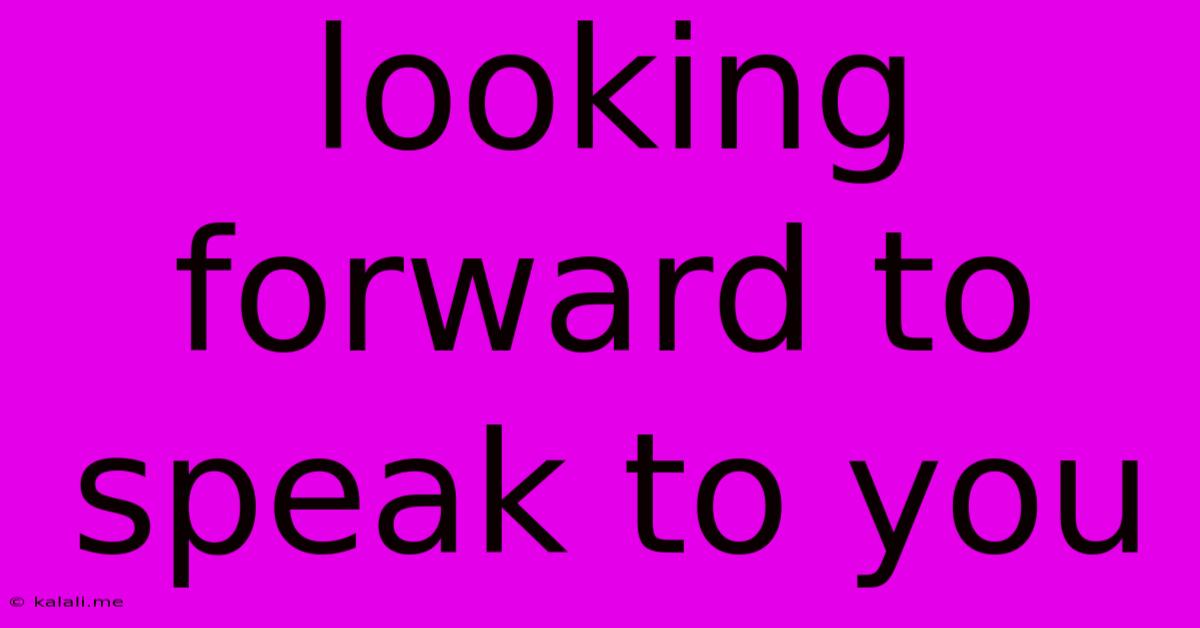Looking Forward To Speak To You
Kalali
May 21, 2025 · 3 min read

Table of Contents
Looking Forward to Speaking With You: Mastering the Art of Professional Correspondence
Looking forward to speaking with you. This seemingly simple closing phrase is a powerful tool in professional communication, capable of setting a positive tone and fostering productive relationships. But its effectiveness hinges on context and application. This article delves into the nuances of using this phrase, exploring its appropriate usage, alternatives, and how to maximize its impact in different communication scenarios.
Why "Looking Forward to Speaking With You" Works:
This closing line conveys professionalism, enthusiasm, and anticipation. It subtly communicates your interest in the conversation and your respect for the recipient's time. Unlike a generic "Thanks," it adds a personal touch, suggesting a proactive approach and a desire for a productive exchange. The phrase also subtly implies a future collaboration or interaction, strengthening the professional relationship.
When to Use "Looking Forward to Speaking With You":
This phrase is most effective in the following scenarios:
- Scheduling Calls or Meetings: When confirming a meeting time or following up on a meeting request, it confirms your enthusiasm and anticipation.
- Email Follow-ups: After sending important information or a proposal, it reinforces your commitment and keeps the conversation moving forward.
- Networking Emails: When reaching out to someone in your field, it demonstrates your interest in connecting and establishing a relationship.
- Formal Correspondence: In professional letters or emails where a more formal tone is required, it provides a polite and businesslike conclusion.
Alternatives to "Looking Forward to Speaking With You":
While this phrase is versatile, offering alternatives keeps your communication fresh and engaging. Consider these options based on context:
- "I look forward to our conversation." (More formal)
- "I'm looking forward to our call/meeting." (More specific)
- "I look forward to discussing this further." (Focuses on the topic)
- "Excited to chat soon!" (More informal, use with caution in professional contexts)
- "Speak soon!" (Very informal, best reserved for colleagues you know well)
Maximizing the Impact:
To ensure the phrase's effectiveness, consider these factors:
- Context is Key: Use it only when genuinely appropriate. Avoid overuse, as it can sound insincere.
- Follow Through: Be punctual and prepared for the conversation. This reinforces the positive impression you've created.
- Tone and Manner: The overall tone of your communication should match the closing phrase. A formal closing needs a formal body.
- Personalization: Tailor the phrase to the recipient and the situation. A slightly altered phrase can enhance the personal connection.
Beyond the Closing:
Remember, the closing is only one element of effective communication. Ensure the body of your email or letter is clear, concise, and relevant to the recipient's needs and interests. A strong opening, a well-structured body, and a thoughtfully chosen closing contribute to professional and impactful communication.
By thoughtfully employing "Looking forward to speaking with you" and its variations, you can cultivate positive relationships, promote effective collaboration, and leave a lasting positive impression on your professional network. Mastering this simple phrase is a valuable skill in today's fast-paced communication environment.
Latest Posts
Latest Posts
-
Why Am I Not Seeing My Friends Posts On Facebook
May 22, 2025
-
What Does Single Tick On Whatsapp Mean
May 22, 2025
-
How To Take Wax Off A Wall
May 22, 2025
-
How To Switch Off Motorola Phone
May 22, 2025
-
Where Is Jesus Christ Superstar Filmed
May 22, 2025
Related Post
Thank you for visiting our website which covers about Looking Forward To Speak To You . We hope the information provided has been useful to you. Feel free to contact us if you have any questions or need further assistance. See you next time and don't miss to bookmark.